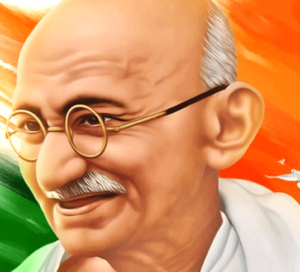Mahatma Gandhi and His Basic Education
Mahatma Gandhi and His Basic Education for Transforming Society
Mahatma Gandhi and His Basic Education for Transforming Society
Mahatma Gandhi and His Basic Education
Mahatma Gandhi was a freedom fighter, a social reformer, an advocate of social equality, a humanitarian thinker and above all the Father of the Nation of India.
Mahatma Gandhi’s original name was Mohandas Karamchand Gandhi. He was born in Rajkot in Gujarat on the 2nd of October 1869. His father Karamchand Gandhi was the Prime Minister of Rajkot. His mother Putlibhai was a saintly lady.
He took his early education in Rajkot and after passing the Entrance Examination he went to England and became a lawyer. Gandhi practised law first in the Bombay High Court. In 1893 he went to South Africa as a bar at law. He went there for a year but under the pressure of circumstance, he happened to spend twenty years of his life in South Africa. During his life in South Africa, he undertook some humanitarian work for the betterment of the Indians living in that land. There he founded farms called ‘Tolstoy’ and ‘Phoenix’ by means of which he tried to educate the illiterate peasants and showed a path of moral and disciplined way of life.
In 1915 he returned to India and took the leadership of the Indian National Congress and undertook several movements such as- the Civil Disobedience Movements, Quit India Movement, Khadi Movements etc. against the British. At last under his leadership, India got independence from the British on the 15th of August 1947.
He was assassinated by a fanatic Hindu named Nathuram Goddse on 30th January 1948.
Besides being a freedom fighter, social worker, he was a great thinker also. As a thinker, he was deeply influenced by the teachings of Vedic scriptures, especially by the Holy Gita. He was also influenced by the writings of Leo Tolstoy and John Ruskin. The pursuits of truth, freedom, social equality, human brotherhood and non-violence in achieving the goal of life were the main basis of his philosophy. He left behind him some theories of his own pertaining to politics, economics, religion, sex life and education. All his theories came out of his practical and experimental life. His theory of education took mould as a reaction to the educational policy of the West imposed upon the Indians.
According to Gandhi, “Education is the all-round drawing out of the best in child and man-body, mind and spirit. Literacy is not the end of education nor even the beginning. It is one of the means whereby one can be educated.” He thought that education should cover the entire field of life and must provide opportunities for the full development of the mental, moral, spiritual and physical attributes of man.
Gandhi noticed that the then-prevailing system of education was not only wasteful but positively harmful. Most of the boys were lost to their parents and to the occupation to which they are born. They pick up evil habits, affect urban ways and get a smattering of everything in which they are involved. Hence he put forward a system of education that is termed as, ‘Basic Education’. The aim of basic education is to transform children into model villagers. According to Gandhi, character-building was completely independent of literary training. It could not be imparted by books. He said, “It can be done through the living touch of the teachers.”
Gandhi made an experiment with his new educational system by founding some Ashram as–Tolstoy Ashram and Phoenix Ashram in South Africa and Sabarmati Ashram and Sewagram Ashram in India.
Gandhi’s educational theory had a clear social orientation. He envisaged the education of the whole man through craft. Gandhi considered the introduction of craft to education for he believed that it would at once transform education, society in general and the personality of the youth. Gandhi had laid a sound educational theory that aimed at character building and it was craft-centered and self-supporting. He did not give an explicit, integrated and comprehensive theory about how his educational institutions were to be managed. However, Gandhi managed his educational institutions very successfully with sound and inspiring academic leadership. He meticulously documented all the details pertaining to the founding and management of his ashrams which were residential institutions where learning and living were designed to be a simultaneous and integrative process.
Gandhi conceived, built and successfully managed his educational institutions through his four successive ‘ashram models’– as mentioned above. All four were pioneering experiments in his respective historical contexts that progressively wove learning and living into a concurrent process. The unique moral genius of Mahatma Gandhi designed a scheme of education in which learning and living were reciprocally transformational processes. His philosophy of non-violence became an increasingly central and dominant motif in each of the successive models.
At first sight, Gandhi was a paradigm case of transformational leadership. Gandhi as a transformational leader recognized and harnessed the needs and demands of his followers to higher purposes. Gandhi did this through a vital teaching role that shaped, altered and elevated the values and goals of his ashram inmates to a higher level through empowerment and inspiration. He wanted to bring about a social change that satisfied his followers’ authentic needs i.e. service to the motherland. In all four ashrams, Gandhi lived with his trusted and disciplined followers and developed transformative goals through open discussions and dialogues with them. Thus Gandhi was able to unearth the needs of others and understood the nature of the followers’ reality. As a part of the moral issues in all his ashram schools, Gandhi gave first priority to developing the culture of the heart as the foundation for building the character of the pupils. For this he trained his followers to be disciplined themselves by practising and observing vows such as- Truth, Love, Chastity, Control of the Palate, Non-stealing, Non-possession of Property, Physical Labour, Swadeshi Outlook, Fearlessness, Removal of Untouchability and Tolerance Gandhi was concerned with moral issues and this helped to raise his followers’ level of consciousness on dimensions like self-sufficiency and community upliftment. Thus he proved to be a transformational leader.
He loved his job and had a great deal of affection for the residents with whom he worked. This passion and personal enthusiasm motivated his followers to perform at their highest levels as well. Gandhi’s passion was a reflection of his ashrams and their inhabitants. Gandhi demonstrated the characteristics of a transformational leader which helped his followers transform themselves and their ashrams. He encouraged creativity, fostered open communication, demonstrated forward-thinking, shared responsibilities and exhibited commitments which helped ashram residents to meet the challenges of the future. Gandhi’s compelling visions provided his followers with a sense of purpose and encouraging commitment. Further, his followers gradually achieved more and pursued a worthy goal. His visions created a real meaning for his followers in establishing a standard of excellence. Gandhi’s effective vision helped to bridge the present and the future, developing a high level of morale among his supporters.
Information was circulated in his ashrams through upward and downward communications. Gandhi’s idea of small, self-contained communities is very conducive to social harmony. He believed in economic and social democracy and promoted the education of equality. Violence had no place in the Gandhian world view. He believed in a social order based on justice, equality and freedom. He never approved the then-prevailing system of education which was not suitable for Indians. Gandhi urged mutual love between the teachers and pupils.
Gandhi was a vertebrate critic of the present-day university education system. He considered education in arts as sheer waste which destroys the mental and physical health of the students and leads to unemployment. It did not fit people for independence but only enslave them. In 1944 he suggested that the scope of his basic educational movement should be extended and it should become literally ‘education for life.’ Thus it should include pre-basic, post-basic and adult education. It should extend from the moment a child is conceived and it should continue till the moment of death. 0 0 0. Mahatma Gandhi and His Basic Education, Mahatma Gandhi and His Basic Education
Mahatma Gandhi and His Basic Education, Mahatma Gandhi and His Basic Education
N. B. This article ‘Mahatma Gandhi and His Basic Education for Transforming Society’ originally belongs to the book entitled ‘Gleaned Essays‘ by Menonimus.
Mahatma Gandhi and His Basic Education, Mahatma Gandhi and His Basic Education, Mahatma Gandhi and His Basic Education
Books of Composition by M. Menonimus:
- Advertisement Writing
- Amplification Writing
- Note Making
- Paragraph Writing
- Notice Writing
- Passage Comprehension
- The Art of Poster Writing
- The Art of Letter Writing
- Report Writing
- Story Writing
- Substance Writing
- School Essays Part-I
- School Essays Part-II
- School English Grammar Part-I
- School English Grammar Part-II..
Books of S. Story by M. Menonimus:
Related Search:











